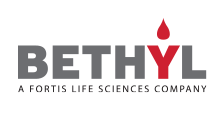Rabbit anti-CARD9 Antibody Affinity Purified

Product Details
Specifications
The epitope recognized by A305-878A maps to a region between residue 450 and 500 of human Caspase recruitment domain-containing protein 9 using the numbering given in entry Q9H257.2 (GeneID 64170).
Immunoglobulin concentration was determined using Beer’s Law where 1mg/mL IgG has an A280 of 1.4. Antibody was affinity purified using an epitope specific to CARD9 immobilized on solid support.
The epitope recognized by A305-878A-T maps to a region between residue 450 and 500 of human Caspase recruitment domain-containing protein 9 using the numbering given in entry Q9H257.2 (GeneID 64170).
Immunoglobulin concentration was determined using Beer’s Law where 1mg/mL IgG has an A280 of 1.4.
Additional Product Information
CARD9 is an adapter protein that plays a key role in innate immune response to a number of intracellular pathogens, such as C.albicans and L.monocytogenes. Is at the crossroads of ITAM-tyrosine kinase and the Toll-like receptors (TLR) and NOD2 signaling pathways. Probably controls various innate immune response pathways depending on the intracellular pathogen. In response to L.monocytogenes infection, acts by connecting NOD2 recognition of peptidoglycan to downstream activation of MAP kinases (MAPK) without activating NF-kappa-B. Also involved in activation of myeloid cells via classical ITAM-associated receptors and TLR: required for TLR-mediated activation of MAPK, while it is not required for TLR-induced activation of NF-kappa-B (By similarity). Controls CLEC7A (dectin-1)-mediated myeloid cell activation induced by the yeast cell wall component zymosan, leading to cytokine production and innate anti-fungal immunity: acts by regulating BCL10-MALT1-mediated NF-kappa-B activation pathway. Activates NF-kappa-B via BCL10. In response to the hyphal form of C.albicans, mediates CLEC6A (dectin-2)-induced I-kappa-B kinase ubiquitination, leading to NF-kappa-B activation via interaction with BCL10. In response to fungal infection, may be required for the development and subsequent differentiation of interleukin 17-producing T helper (TH-17) cells. [taken from the Universal Protein Resource (UniProt) www.uniprot.org/uniprot/Q9H257].+B3:B11
Alternate Names
CANDF2; caspase recruitment domain-containing protein 9; hCARD9
Applications
All western blot analysis is performed using 5% Milk-TBST for blocking and as antibody diluent. Primary antibody is incubated overnight.
Western blots of cell lysates are performed using Goat anti-Rabbit IgG Heavy and Light Chain Antibody (Cat. No. A120-101P).
Western blots of immunoprecipitates are performed using Goat anti-Rabbit Light Chain HRP Conjugate (Cat. No. A120-113P) with 5% Normal Pig Serum (Cat. No. S100-020) added to the blocking buffer.
